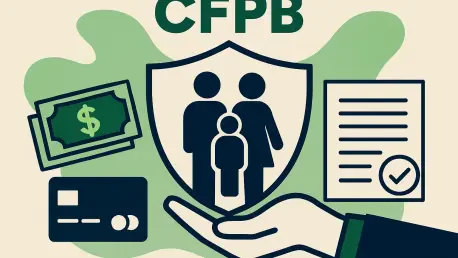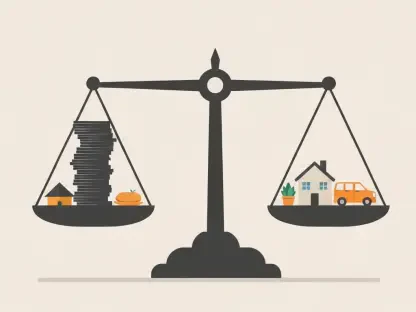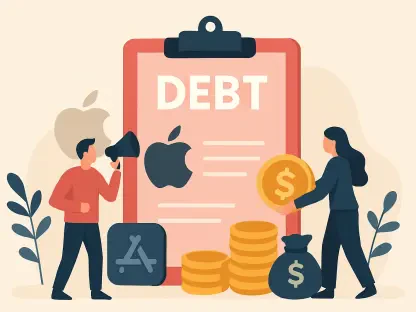What happens when the guardian of consumer finances decides to tighten its focus, potentially leaving some risks unchecked, and how will this impact millions of Americans? Picture a payday lender or a fintech app operating just beyond the reach of federal oversight, free to push questionable practices without scrutiny. This scenario looms large as the Consumer Financial Protection Bureau (CFPB) unveils a controversial rule change in 2025, aiming to redefine its supervisory power over nonbank financial entities. This isn’t just a bureaucratic adjustment—it’s a shift that could alter the balance between consumer safety and industry freedom, stirring heated debate across the financial landscape.
The Stakes Behind the Rule Shift
This proposed change isn’t a mere footnote in regulatory history; it’s a pivotal moment for millions of Americans who rely on the CFPB to shield them from predatory financial practices. Established after the 2008 crisis, the bureau has been a critical watchdog over nonbanks like debt collectors and online lenders. Yet, its inconsistent approach to designating firms for supervision has long frustrated industry players craving clarity. Now, with a new rule aiming to standardize oversight, the question arises: will this bring fairness, or will it shrink the safety net for consumers at a time when financial scams are surging?
Unpacking the CFPB’s New Framework
At the core of this proposal is a redefined standard for what constitutes “risks to consumers” when deciding which nonbanks warrant CFPB oversight. Historically, the bureau relied on case-by-case orders, creating uncertainty for firms about whether they’d fall under scrutiny. The new rule, announced on August 26, seeks to bind the agency to a consistent framework, prioritizing serious misconduct over broader, less defined threats. While this could lower supervisory costs for businesses and foster compliance through clearer guidelines, the CFPB itself concedes that fewer nonbanks will likely be targeted. This narrowing scope sparks concern about whether emerging or subtle harms might evade detection under the stricter criteria.
The implications ripple beyond mere numbers. A focused definition might streamline operations for the bureau, aligning more closely with congressional intent as interpreted by current leadership. However, consumer advocates worry that practices not deemed “serious” enough could still exploit vulnerable populations, especially in fast-evolving sectors like digital finance. With public comments open until September 25, this rule stands as a litmus test for how much protection the agency is willing to sacrifice for predictability.
Industry and Expert Reactions to the Change
Voices from across the spectrum are weighing in on this seismic shift. Industry leaders have expressed cautious optimism, with some noting that a predictable standard could reduce legal risks and compliance burdens. A financial trade group representative remarked, “Clarity in regulation helps firms plan and innovate without fear of sudden oversight.” Yet, this enthusiasm is tempered by concerns from consumer rights groups, who argue that a narrower focus might embolden bad actors operating in gray areas of the market.
Experts also highlight a stark change in the CFPB’s tone under Acting Director Russ Vought, whose tenure marks a pivot toward deregulation. Unlike the aggressive enforcement seen in prior years, Vought’s leadership has overseen workforce reductions, funding cuts, and the closure of nearly 2,000 pending cases. One policy analyst observed, “This rule fits a pattern of scaling back the bureau’s reach, potentially at the expense of consumer trust.” These contrasting perspectives underscore a deeper ideological clash over whether the agency should act as a strict enforcer or a lighter-touch regulator.
The Bigger Picture of Agency Transformation
Beyond the specifics of this rule, a broader transformation is unfolding at the CFPB. Under Vought’s direction, the agency appears to be retreating from its once-robust watchdog role, aligning with a push from Trump administration officials to curb regulatory overreach. Reports of rescinded guidance and dropped legal actions against banks and fintechs paint a picture of an institution in flux, prioritizing business interests over expansive consumer protection. This shift raises questions about the bureau’s capacity to adapt to new financial threats in an era of rapid technological change.
The timing of these changes adds another layer of complexity. As digital payment platforms and cryptocurrency ventures proliferate, the need for vigilant oversight arguably grows. Yet, the CFPB’s apparent pullback—evident in both policy and resource allocation—suggests a gamble that market forces might self-regulate emerging risks. Whether this bet pays off or leaves consumers exposed remains a critical uncertainty hanging over the agency’s evolving identity.
Navigating the Impact on Consumers and Firms
For everyday Americans, this rule change demands heightened awareness. Those interacting with nonbank entities must familiarize themselves with existing rights under laws like the Consumer Financial Protection Act, especially if oversight shrinks. Advocacy groups are urging the public to submit feedback before the comment period closes on September 25, emphasizing that collective voices could shape the final outcome. Staying informed about predatory practices and reporting issues promptly could become even more vital if certain risks fall outside the CFPB’s narrowed gaze.
Meanwhile, nonbank firms teetering on the edge of supervision face a different calculus. The proposed “serious conduct” standard offers a chance to reassess operations and align with clearer expectations, potentially avoiding regulatory heat. Legal consultants are advising clients to scrutinize their practices now, anticipating that proactive adjustments could spare future headaches. For both consumers and businesses, adapting to this evolving landscape means staying ahead of the curve, whether through advocacy or compliance.
Reflecting on a Pivotal Moment
Looking back, the CFPB’s decision to redefine its oversight scope marked a turning point in the delicate dance between regulation and deregulation. The rule, with its focus on serious misconduct, aimed to bring order to a previously inconsistent process, offering predictability to an industry long frustrated by uncertainty. Yet, it also mirrored a broader retreat under leadership that favored a lighter regulatory hand, leaving lingering doubts about the bureau’s commitment to consumer safety.
As the dust settled, the path forward became clear: stakeholders had to take ownership of the outcome. Consumers needed to push for robust protections through public engagement and advocacy, ensuring their voices shaped future policies. Firms, on the other hand, had to balance innovation with accountability, recognizing that regulatory clarity didn’t equate to a free pass. Ultimately, the legacy of this change depended on how both sides adapted to a financial world where oversight might no longer cover every shadow.









